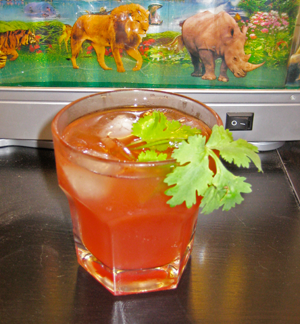I did a bartending gig this evening. It was enjoyable and interesting. The degree to which people’s behavior towards me is different depending on the role I occupy has always intrigued me. The most popular order today, after the Margarita, was the mojito. It’s a pretty good drink.
1 oz. white rum
1 oz. fresh lime juice
1 oz. sugar
fresh mint, several sprigs
Put the mint at the bottom of an old-fashioned or highball class, pour the sugar on top of it, and pour the lime on top of the sugar. Muddle these ingredients until the sugar is well dissolved, and mint well crushed. Now add the rum and some ice. Garnish with lime.
Whatever you do, do not buy the “mojito mix” that is sold at the store. That stuff is crap. Using real lime juice and real sugar makes a much better drink.
This drink seems to be a traditional beverage out of Cuba. It seems that for a very long time, it has been what field workers there drink during their breaks, to fight off the heat. And indeed, it’s good as a coolant. Today was a hot day, and I think that’s one reason so many people wanted this drink specifically. It’s interesting that what works for a thirsty Cuban field hand in 1893 also works for a thirsty middle-class party-goer in San Leandro in 2010.
Just to be tiresome, I want to note that this drink is interesting in that it is both a sour and a bittered drink. It follows the “sour” recipe (a spirit, with equal parts sweetener and citric acid) and also the “bitter” recipe (a spirit, with both a sweetener and a bitter). The mint here is playing the role of a bitter. It is interesting to taste something that interacts at once with both the sour and bitter receptors on the tongue.
{ 0 comments }













 Shake or stir the following and serve on ice in an old-fashioned glass. The garnish of a sprig of cilantro adds a wonderful complexity and tingles your taste buds.
Shake or stir the following and serve on ice in an old-fashioned glass. The garnish of a sprig of cilantro adds a wonderful complexity and tingles your taste buds.


